#hyoscyamine
Explore tagged Tumblr posts
Text
Hmm. That comic gave me the idea to get a tiny jar necklace and put a single important pill on it to wear, but which of my meds should I keep close to my heart?
#not Valium because i so don't want to get in trouble for carrying a controlled substance like that#lamotrigine#aripiprazole#hyoscyamine#spellcheck on that last one#truvada#hmm emergency PrEP has a good ring to it#tho it's a pretty big pill#so is Allegra#everything else is vitamins or injections#oh wait#celebrex#cyclobenzaprine#tylenol otc#i know the in the original comic it was hrt but I'm tagging this post as#cripplepunk
7 notes
·
View notes
Text
Protip do you want to try Datura but you're too scared by the probable death and disability you'd face if you took too much? Go to the pharmacy and say you're having an ibs flare up and ask for something called buscopan.
It contains hyoscyamine, which is very similar to scopolamine. Then you grind up like an 1/8th or 1/4th of one of the tiny white pills and smoke with a bit of your preferred leafy plant. This converts the hyoscyamine(which has trouble getting past the bbb) INTO scopolamine(which is one of the psychoactive components of datura/henbane)
Do NOT overdo it. Apparently just 1 20mg pill can make you vividly and unpleasantly hallucinate. Do NOT do this in excessive amounts if you value your mental clarity, your physical safety, and your legal freedom.
FYI these drugs cause dementia so don't do this more than a few times. The point of this post is to give people access to an otherwise very unpredictable and dangerous drug in a dose controlled way.
#drugs#drugblr#cw drugs#tw drugs#datura#hyoscyamine#hyosine#scopolamine#deleriant#delerium#unsafe drugs#high for what#girls who do hard drugs#drugs mention#legal highs#legal drug#fun?#henbane
4 notes
·
View notes
Text
i cant wait to see the motility specialist soon bc jesus fuck my stomach is a mess
i have a feeling i have motility issues going on in my intestines aside from my gastroparesis
#i have never been more grateful for my hyoscyamine prescription in my life#its also only five days until my wheelchair eval holy shit
4 notes
·
View notes
Text
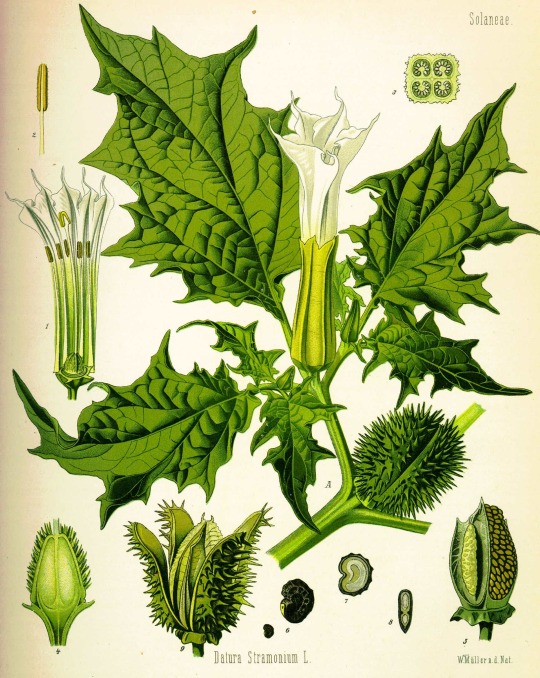
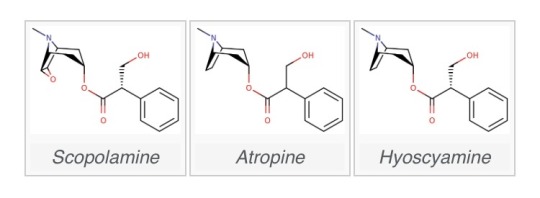
DATURA (D. STRAMONIUM) ☠️🥀
Datura is a genus of nine species of poisonous flowering plants belonging to the family Solanaceae. Datura is known as powerful and dangerous deliriants, used for shamanic and medical purposes, as well as poisons. They contain the potent anticholinergic substances scopolamine, hyoscyamine, and atropine primarily in their seeds and flowers. The reported effects post-ingestion have been commonly reported as states of psychotic delirium, longterm amnesia—and oftentimes results in fatality.
386 notes
·
View notes
Text
Everything You Need to Know About Herbs: Belladonna *Deadly Nightshade*
Belladonna (Atropa belladonna)
*Poisonous *Medical *Feminine

Folk names: Banewort, Black Cherry, Deadly Nightshade, Death’s Herb, Devil’s Cherries, Divale, Dwale, Dwaleberry, Dwayberry, Fair Lady, Great Morel, Naughty Man’s Cherries, Sorcerer’s Berry, Witch’s Berry
Planet: Saturn
Element: Water
Deities: Hecate, Bellona, Circe
Abilities: Protection, Psychic Abilities, Self-Awareness, Astral Projection, Forgetting Past Love
Why Poisonous?: Its roots, leaves and fruits all contain alkaloids: atropine, hyoscyamine, and scopolamine. This causes dilated pupils, blurred vision, slurred speech, hallucinations, delirium, convulsion and some cases death.
Do not consume belladonna in any form
Characteristics: It has a rigid stalk that grow into branches. It is a perennial plant and can grow up to 3 feet tall. Its purplish-brown flowers are shaped like bells with its berries being black and the size of cherries. It is a part of the nightshade family and likes partial shade in chalky soil.
History: This plant has always been associated with witches and was used as an ingredient in flying ointment, a medieval cream that allowed people to unlock their spiritual powers. Belladonna was used by the Scottish army against the Norwegian troops of King Svein Knutsoon to incapacitate them when they were trying to overthrow the current King. Sacred to the Fates, it is also associated with the Fate Atropos, the Fates who cuts the thread of life. Its leaves were used by Venetian women in order to redden their cheeks, and Renaissance women used it as a tincture in order to dilate their eyes to seem more attractive.
Growing Belladonna:
Easy to grow? No
Rating: Expert/Low Success Rate
Seeds Accessible? No and Illegal in some areas
Growing Belladonna
Video Guide
Where to Get Seeds
Magical Usage:
Was used to encourage astral projections and produce visions (Is very much not safe)
Amplify seductive energy and give temporary illusion of beauty
Placing belladonna in a sealed jar can help your spirit move into the world beyond
The priest of Bellona, the Roman Goddess of War, would drink an infusion of Belladonna prior to worshipping Her and invoking her aid. The antidote for Belladonna poisoning is physostigmine, a reversible cholinergic medicine that is used to treat glaucoma and antimuscarinic toxicity.
Medical Usage:
Was used as an anesthetic for surgeries
Sources
#witchcraft#green witch#witchblr#witch community#herbalist#occulltism#plants and herbs#paganblr#bellodonna#dangerous#magick#occultism#hecate#dark academia#witchcraft 101#seeds#gardening#witch garden#plantblr#plants#botany#witch tips#witches of tumblr#witchcraft resources#witch blog#beginner witch#herbalism
109 notes
·
View notes
Text
Just thinkin' about Nightshade: The Meaning of a Name
This started out as me thinking about how much I love their beast mode, and turned into thinking about their designation.

So, for those who might live in regions where Nightshade doesn't grow naturally, Nightshade is massively, massively poisonous.
So much so, that it's called Deadly Nightshade. In the UK, it's famous for being the plant that Macbeth probably used to poison Duncan's troops.
I always grew up hearing it called Belladonna, which is part of its Latin name, Atropa belladonna.
"Atropa" comes from "Atropos", the name of the Grecian Fate who severs the thread of life. (If you've seen the Disney Hercules movie, this is the Fate who cuts the thread with scissors.)
It has a beautiful purple and yellow flower, more reminiscent of Tarantulas' colours than Nightshade's.
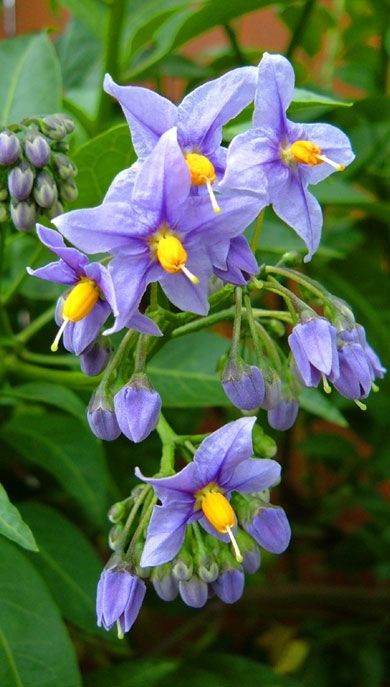
It also features little black/dark purple berries.
Now, Nightshade is a great name for a bot that turns into an owl.
The name doesn't necessarily have anything to do with the plant.
However! I'm overthinking it anyway, so let's goooooo
Bad Implications!
What's super interesting is that Deadly Nightshade has some symbolic meanings in the UK/Europe; Namely, that Nightshade is one of the Devil's chosen plants, and that eating it (especially the berries) would bring Satan's wrath down upon the consumer as punishment.
It can represent danger, risk, betrayal, punishment, hopelessness, and sometimes even murder.
Plants with similarly mythologised toxic properties are Pennyroyal and Juniper-- Both of which can harm humans in various quantities.
(Interestingly, Pennyroyal is still sold in the UK as an insect repellent, and I even have some in my closet and drawers to repel moths-- But it is most famous as a risky historical abortifacient. I am usually asked for ID when I buy it in London Bridge Market, and they ask if you are familiar with it's use/inform you not to consume it when you buy it.
Juniper is most famous for being a common ingredient in sloe gin, but only in careful amounts. We've seen people in A&E come in with kidney pains from trying to make homemade gin, who ended up poisoning themselves by using the wrong type of juniper berry, or by concentrating it too much. Juniper was also considered a risky historical abortifacient.)
But in regards to Deadly Nightshade, a lot of people have hurt themselves trying to take advantage of its psychoactive properties-- Primarily in the form of the hyoscyamine and scopolamine (tropane alkaloids) found in the plant. However, the dosage is too finnicky, and it's way too easy for someone to poison themselves by accident. It's happened before. :( This plant is far too dangerous to use for these purposes. Do not consume!
But because of this connection with psychoactive properties, Deadly Nightshade is also sometimes symbolic of altered states of mind, having visions, or esoteric/magical thinking.
You can see this in a few fine arts works throughout history, various bits of folklore, and other historical media such as stage plays since audiences would be familiar with this plant as being a potential poison (thus making it a good choice for a playwright to work into a story).
Medical Applications!
The medication Atropine was first created via concentrated extracts derived from Deadly Nightshade. It has multiple medical applications, and can be concentrated from other members of the Nightshade family of plants, not just Belladonna.
Interestingly, although it can be poisonous on its own if someone decides to munch on the plant or its berries (a bad idea, do not eat any part of this plant ever), medically concentrated Atropine can be used in healthcare environments when administered appropriately to help address certain organophosphate poisonings by blocking muscarinic receptors by way of disrupting the neurotransmitter Acetylcholine.
Something that is sort of interesting is that historically, people used to put small amounts of liquid concentrated Deadly Nightshade into their eyes, as this resulted in very dilated pupils. This was considered a desirable cosmetic effect, hence the "Belladonna" part of the plant name-- It means "beautiful woman"! And Nightshade absolutely has large, round eyes with big pupils. (Do not put this shit in your eyes, it is a bad idea. Do not fuck with poisonous plants in general. Just need to be super clear on this!)
Again, that's an owlish trait, and it doesn't necessarily have to do with the plant. But I like that it could go either way.
I've also spotted Deadly Nightshade growing in overgrown cemeteries in the south of England, typically those that are near wooded/forested areas. So it's interesting that Nightshade got their alt-mode in a cemetery near a forest, since this plant is known to grow in woodlands.
But I wonder if Nightshade's name might have multiple implications; Especially considering their relationship with Tarantulas-- who we still haven't seen again, as of yet anyway-- it will be interesting to see how things play out.
Hopefully this is at least interesting trivia! :)
Also, Obvious PSA: Once again, don't eat any of the plants/flowers/berries mentioned here, you can die or suffer a surprisingly large amount of pain/potential organ damage. Either way, don't eat this stuff.
#nightshade#tfe nightshade#earthspark#maccadam#maccadams#long post#just thinkin'#tfe#medbay posting#transformers earthspark
91 notes
·
View notes
Text
Chemistry behind Datura

🌺 Mandragora, a mystical plant with potent hallucinogenic properties, hails from India and carries an air of ancient religious significance. Beware, for the entire plant is toxic, with the seeds holding the highest toxicity. Its primary toxic components are Hyoscine and Hyoscyamine, both known for their mind-altering effects. In ancient times, Mandragora played a role as a key ingredient in "sweating potions," akin to a mesmerizing elixir. Legend has it that the renowned Chinese anesthetic "Mafeisan" invented by Hua Tuo was derived from plants like Mandragora.


#datura#Mandragora#indian tumblr#flowers#organicchemistry#chemistry#chemblr#stemblr#study blog#did u know#interesting#amazing facts
60 notes
·
View notes
Text
Datura’s Daughter
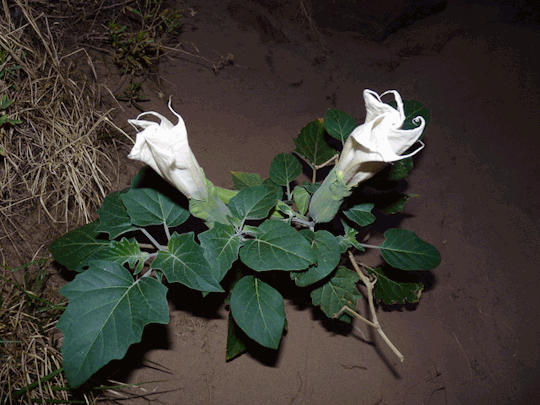
Reading Key 🔑
OPEN & LISTEN/READ ALL LINKS. THIS IS FOR UNDERSTANDING.
ALL LINKS ARE UNDERLINED RED
I had briefly read about Datura as a late teen/20-year-old. The plant intrigued me and was always in the background of my walk (studies). She wasn’t of utmost importance to me regardless of Her ever presence. I simply wasn’t ready...until I was.
My stumbling upon Datura in real life was serendipitous and so so unexpected.
August 2019, I was having a full moon stroll with a beloved musical genius. We will call him FireBird.
FireBird and I were discussing the Andromedin star system, and the Arch(acnid)s of Time. He and I tended to get deeply esoteric with each other. He kept up with me AND expounded upon conversation to the point where I found myself having to keep up with him. Despite the craziness of our connection, he and I were kin in that way. Hearts that sincerely sought to be One with Mystery.
Selene in Her fullness beamed down on us. Crickets sang their song, and East Atlanta’s humidity cloaked our skin.
We’d came across his neighbor’s house like we did a million times before, but I guess this night the neighbor’s Datura blooms were at peak ripeness just for us to see.
The flowers held their faces up towards the moon. Their sentient, Gramophone petals bellowing out Her intoxicatingly quiescent aroma. I gasped. Literally. In awe.
FireBird was off put, but I told him it was Sacred Datura, and he trusted my giddy response. Omg FireBird, I read about that plant before, see! Come on!
I innocently went over to the neighbor’s yard and inhaled with my whole lung. I picked a flower and nectar spilled over my fingertips. I eagerly put the flower in his face for him to inhale and experience Her as well.
I was ignorant that an inhale + nectar absorbed through skin alone will send you on a trip- though not nearly as deadly as ingesting the seed. Things got creepy, crawly, hilarious, scary, and <<*~FreaQQy~*>> (freaky::frequency), to say the least. An unplanned Datura encounter is an initiation in and of itself. This animalistic plant tends to stay with you. Your shadow is the humectant, and Datura is the moisture. I have learned that it is possible to come across certain plants and be inside their vortex…indefinitely.
Four years have passed, and I have been inside Datura’s Fib0nacci ever since- with less intensity as time goes on.
Here is some of what She’s revealed to me…
Vision Quest & Flying Ointment
Datura (Thorn Apple, Jimsonweed, etc.) belongs to the Solanaceae family- the same family as tomatoes, potatoes, and bell peppers. She is a weedy perennial, with large trumpet blooms, and stanky, menacing leaves. Solanaceae is unique in that several species contain the presence of strong alkaloids. Alkaloids are multifaceted organic plant compounds, and can be toxic to humans in even low amounts. Within Datura are three tropane alkaloids: atropine, hyoscyamine, scopolamine. Of the tropanes in Datura, hyoscyamine tends to have higher concentration; however, depending on the species + time & place of harvest, tropane concentration may vary. Datura’s alkaloids (as with all Solanas) effect the body in a host of ways, but the most common are pupil dilation; reduced secretions from respiratory, urinogenital, salivary, and other mucosal glands; effects on the sympathetic and parasympathetic nervous system; rapid increase or decrease in heart rate.
Datura is a deliriant under the hallucinogen umbrella. In the offshoots of reddit, one can find the r/Datura community where users describe their Datura horror stories. Deliriants (aka derailments) trigger erratic behaviors that can endanger others or self, strong hallucinations, hysteria, an inability to realize that one *is* hallucinating, vivid dreams, memory loss, true dysphoria, and more. Unfortunately for most...Datura’s hallucinations are that of a waking nightmare. Ain’t nothing cute and lighthearted about Her.
Despite Datura’s terrifying association, She has been recorded for medicinal and spiritual purposes amongst various groups throughout the world. I find, as with most toxins and venoms, that the cure is hidden within the poison. It is painfully clear that earlier generations were aware of this knowledge when compared to modern people’s haphazard use of Datura. It seems as though, for the same effects tropane alkaloids cause, they can also relieve them as well.
Datura (+ Her other tropane containing sister flowers) assist with: easing migraines, pain, & muscle spasms; curbing mucosal excess; rectifying cognitive problems stemming from spine injury; settling motion sickness & nausea; regulating cardiac arrythmia; unraveling violent PTSD and sexual traumas; and even calming asthmatic fits (when smoked). Speaking of smoke, ain’t it funny how Datura is in the same family as Tobacco? A common hallucination people report is that cigarettes appear out of thin air- and they have a smoke. Once they’re done smoking, the cigarette reappears again, and they are compelled to do it over again. Is it that during this hallucination, the body is attempting to regain control over respiratory function? Who knows...
According to Kymia Arts, fire neutralizes tropane alkaloids, and ol plant lady Emma Dupree states here (@ minute 13:13) that dried Datura leaves “help em get they breath.”
In homeopathic practices, specialists name those who could benefit from Datura as a Stramonium person. In extreme cases, this person has a deep fear of the dark, fear of danger, homicidal tendencies, an aversion to water, reflective surfaces, and being alone. They can be epileptic, manic, rageful, and schizophrenic. In mild cases, they can be dyslexic, have poor speech, or muscle ticks. I intuit that Datura heals these ailments because spiritually, this person is already in Her realm...and only She can reclaim & set you free. She allows one to overcome their fears by *leaving* it at Her doorstep. For She eats fear and all arcane things for dinner...
On the inverse, Datura intoxication causes extreme dry mouth/throat, extreme thirst, speaking in tongues/babble, auditory phantoms, incoherence, loss of motor function, inability to read, inability to *perceive* danger, and (hopefully) temporary madness...
As I said before, Datura has been used worldwide by a wide range of groups. According to Pharmako Gnosis, the Tsonga of South Africa “use Datura fatuosa in girls’ initiation ceremonies for exorcism. After the ingestion of a decoction of Datura root, the ceremony is marked by dancing, rapid drumming, disrobing, and the invocation of a blue-green pattern of the ancestor spirits” (p. 248).
One of Kalifornia’s indigenous tribe Chumash were known to use Datura ritualistically as well. For them, the main purpose of Datura consumption was to receive the gift of a dream helper. The Chumash chose the female Datura plant, dried Her root, and chewed the dried root during winter [Saturn’s season::Datura’s planetary ruler]. It is reported that their ceremonies with Datura were called Vision Quest (in Chumash Mother Tongue of course). One can even find the term Vision Quest in modern media; a prime example is in the suspense-horror film “Us” directed by Jordan Peele. There is a reoccurring scene where small girl is sent to a creepy mirror filled “funhouse” with the banner Vision Quest over the top. That “funhouse” is akin to a Datura trip...
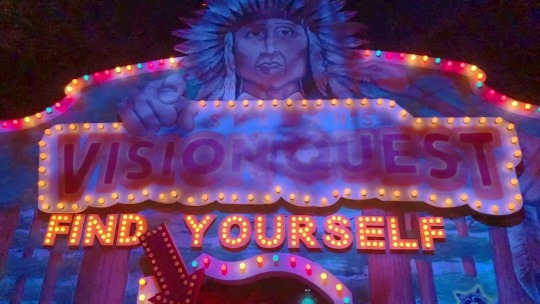
In India, the powdered seeds were mixed with butter and taken internally for impotence as well as being applied to genitalia to obtain sexual vigor (Lewis 1977:330). Referred to as the tuft of Shiva, the god of destruction, Datura was also used in the form of a liquid extract by thugs - worshipers of Kali, the goddess of fertility and death - to stupefy sacrificial victims. The plant was also given to young girls in India to bring them Into prostitution as well as on their clients (Siegel 1989:21). The leaves were smoked as well in that country to relieve asthma (Lewis 1977:395).
Datura metel. Phytognosis.
In European traditions, plant women were known to create flying ointments containing Datura or another tropane containing Solanas. It is possible that the creation of flying ointments are a part of why women during that time were accusing of “flying on brooms.” It is said witches would apply flying ointments to their brooms, or even to their vuvlas for aphrodisiac effects.
“All of the tropane plants were major ingredients in various “flying ointments,” along with sundry other dangerous and nefarious substances such as water hemlock (Cicuta virosa), hemlock (Conium maculatum), monkshood (Aconitum napellus), opium poppy (Papver somniferum), soot, baby’s fat, bat’s blood and poplar (Populus spp.) Pharmako Gnosis. (245).
Another hallucination people have reported is a feeling of flying, or the sight of levitating beings. I attribute the flying sensation to an increase in heart rate. Interestingly, I have a hunch that users may also be experiencing the essence/spirit Datura’s primary polliantor, the nocturnal Sphinxmoth.

Now I want you to take the time to read this. Below is an instagram caption from artist and chemist Bryan Lehto of Bio Temple Hawaii.
This amino acid (Tropane) plays a critical role in a variety of biological processes, from the formation of bird feathers to the synthesis of tropane alkaloids and the production of polyamine spermidine. The presence of ornithine in nature is a reminder of the intricate connections. Birds are perhaps the most well-known source of ornithine in nature. This amino acid is a critical component of the keratin that makes up bird feathers. Ornithine is an important precursor to the synthesis of the amino acid arginine, which is used to make the keratin that forms feathers. Without ornithine, birds would not be able to maintain their distinctive plumage and would be unable to fly or regulate their body temperature. Interestingly, ornithine is also a precursor to the synthesis of tropane alkaloids. These are a class of organic compounds found in a variety of plants, including belladonna, henbane, and jimson weed (Datura). Tropane alkaloids are known for their psychoactive properties and have been used for medicinal and ritual purposes such as flying ointments for centuries. The presence of ornithine in these plants that underlie their pharmacological effects. Their poisonous berries are spread by birds. Ornithine is a precursor to the synthesis of the polyamine spermidine. This compound is found in all living cells and plays a crucial role in a variety of cellular processes, including DNA replication, protein synthesis, and cell division. Spermidine is involved in the growth and development of plants, as well as the maturation of sperm cells in animals. An intermediate in the biosynthetic pathways of both tropane alkaloids and spermidine are the compounds of putrescene and cadaverine, the odors of death. If we look at the metaphors present in the biological processes of the amino acid ornithine, we see not only the metaphor of flight but the leitmotif of death, the underworld, and the resurrection of new life.”
Cool rite?
Let’s keep going...
Vampire Squid from Hell
When Datura (or any other powerful plant) takes you into its vortex, intel about its occulted aspects finds its way to you without overt searching. She made it clear soon after our encounter that She is a land-dwelling expression of a cephalopod named Vampyroteuthis Infernalis, or Vampire Squid from Hell. Vampyroteuthis Infernalis hasn’t had many extreme changes over the course of its 350-299 million year existence. It is considered a living relic, which means the genetic wisdom of this creature is still intact for us to observe and understand.
One can detect the energetics of Datura in the location, and physiology of Vampire Squid.
Vampire Squid dwells in the Mesopelagic Zone of the Ocean where oxygen becomes sparce. This deepening end of the Ocean is coined the oxygen minimum zone (OMZ). The Mesopelagic is also attributed the phenomena of twilight. Lingering sunlight wanes rapidly into darkness, and temperature sharply declines as depth increases. The lines between the surface waters and the abysmal deep begin to transition here. Let’s consider the Ocean’s surface, or Epipelagic Zone as Datura’s inviting flower, and the abysmal home of Vampyroteuthis (OMZ) as Datura’s Lethal Alkaloids. Dawn. Dusk. Twilight.

Organisms that live in this level begin to display bioluminescence. Their eyes & physical form take on an…alien, strange appearance.

Vampire Squid reportedly has the largest eyes in the animal kingdom, an adaptation needed to capture any glimpse of light in the endless black seas. It’s 8 arms are webbed and tipped with bioluminescent photophores. The underside of its webbing is decorated with fleshy spikes. When irritated, Vampire Squid will cloak itself in its arms, exposing these spikes. It not only takes on the shape of Datura’s inflorescence, but also Datura’s radical seed pod.

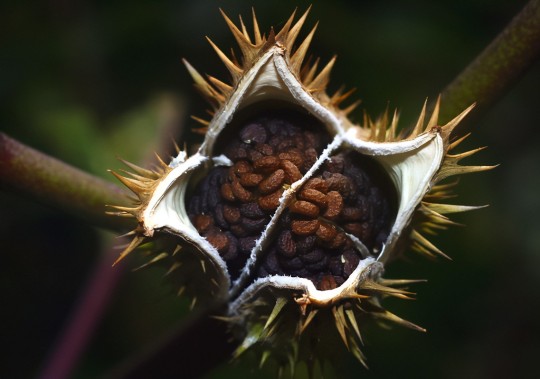
[Photo Credit: Pinterest; Bing Images]
This blue-blooded cephalopod lives primarily in a resting state. Due to such low oxygen levels, it must maintain a low metabolism to conserve energy, and even possesses certain enzymes associated with anaerobic metabolism. The likelihood of Vampire Squid coming across live prey is rare- and so it feasts on detritus (decay, feces, mucus, “marine snow”) that sink from the Ocean’s surface.
When reading about Vampire Squid, one fact that stood out to me is that they have “weak musculature but maintain agility and buoyancy (in the OMZ) with little effort due to sophisticated statocysts (balancing organs akin to a human's inner ear)(Wikipedia). Recall Datura’s aforementioned Gramophone petals? And Vampire Squid’s webbed arms? Don’t they look like triplets? What’s the connection?
Here are some field notes:
Oxygen Minimum Zone::OMZ::Ohms::Ω::OM:: H0me:: The Highly Contagious Viral Realm of Shadows:: Consequence of Datura’s toxic alkaloid scopolamine that causes respiratory failure [OXYGEN IS SPARCE]. Alchemist Kymia Arts states that the plant can cause one to suffocate themselves, as they drift off unconsciously into delirium. You won’t realize you’re drowning.
Gramophone::Grandma Phone::Recordings of the Crone [Saturn; ruling plant of Datura]. Hell’s Record Keeper.
Download:: Datura somehow has a mechanism on the human inner ear (statocyst, Vampire Squid buoyancy) causing auditory hallucinations… the intoxicated victim is finally able to hear the sounds of their own inner hell. Their internal Oxygen Minimum Zone.
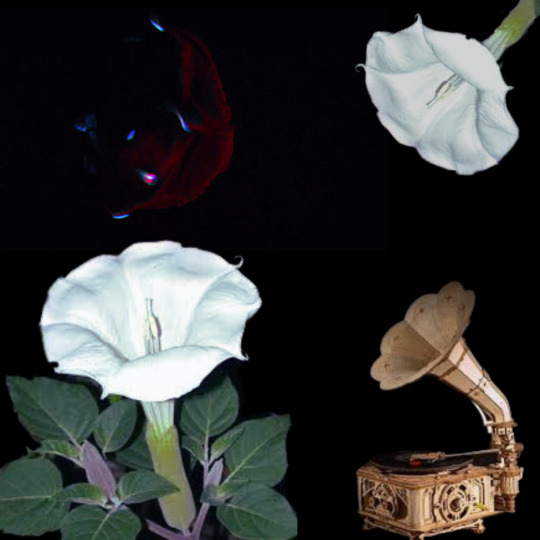
Datura’s Daughter Short Materia Medica
Planetary Ruler: Saturn, Venus, and Mars
Energetics: Extremely Drying & Bitter; Drying action Causes Heat
Z0diac: Capricorn, Scorpio, Libra
Organ Systems: Sympathetic & Parasympathetic Nerves, Respiratory, Cardiovascular, Neuromuscular, Urinogenital
Properties: Deliriant, Hallucinogen, Shamanic, Poison, Anodyne, Antispasmodic
Associations: Death, Rot, Blood, The Devil, Decay, Madness, Hysteria, Fear, Trauma, OMZ, Gramophone, Vampyroteuthis Infernalis, Flight, Levitation, Sphinx Moths, Animalistic Urges, Indigenous, Folklore Traditions, Thugges of India (Datura shows who Thugs *really* are), Queen Toloache, Alice in Wonderland Queen of Hearts, Smoking, Lord Shiva, Chumash (California Condors), Initiatory Practices of men & the young.
WARNING: Datura no longer respects or trusts 99.9% of humans. This is why so many Datura abusers don’t learn any lessons from Her as they would Psilocybin. Approach Datura with the utmost respect, sincerity, and innocence and you *might* be spared...
One night, a long time since that East Atlanta evening, I was tending to my garden. I had my playlist on shuffle. The song Throw Yo Sets in Da Air by Three 6 Mafia came on. I peeped my little Jimsonweed Datura dancing to it, specifically to the first verse given to us by the late Gangsta Boo, the Devil’s Daughter, and my inspiration for Datura’s Daughter. She gave me a wink and said She liked that verse! Haha. And so, from that day, Gangsta Boo’s verse has become what I call Datura’s Chanting Prayer. Linked below.
RIP Gangsta Boo
The Devil’s Daughter::Datura’s Daughter Chant Prayer
I think I finally have located the Gates of Death
Lie awake at Night to hatch my Evil plots I find Myself
Stumbling thru the Dark up against the f*ckin Verge of Sins
Bodies in my yard- Oh My God the Demons came again
People don’t you worry cus Datura’s Daughter got a plan
Ho, eternal burning you will have if you don’t comprehend
Understand this sh*t a Gangsta Bitch is sayin to ya Dawg
Lock you in the trunk mob thru the Night within a Mist of Fog
Never Fear a Nigga callin himself a Killer- wassup Bitch?
Boy you claim you so gahdamn Buck Wild wit that weak ass sh*t
Chillin at the hideout, smokin out, not worried bout a thang
Ballin through Black Haven deep as hell in that Suburban mane
Always watchin my back cus Niggas will jack you for your f*ckin sh*t
Female I am but don’t give a damn if I split some bustas bitch’s wig
Three 6 Mafia Niggas including one Female that’s bumping so Hard on you hoes
The only one talking that shit is these jealous ass niggas && all playa hatas you kno...

DISCLAIMER: I do not promote or recommend ingesting Datura AT ALL. Datura CAN and WILL kill you. Datura can cause PERMANENT psychosis/schizophrenia, blindness, and damage to the heart, liver, and kidneys. If ingested/applied topically, it must be done with the assistance an EXPERIENCED plant professional in THERAPEUTIC DOSES ONLY. Therapeutic doses are EXTREMELY diluted or combined with other alkaloid balancing compounds.
DO NOT INGEST DATURA. She is not a psychedelic. She is a DELIRANT in even moderate doses. For experiences similar to mine, sincere and respectful communing with a live Datura plant is all that is necessary. You can still be impacted (spiritually) by Datura without taking that risk...
DO NOT work with Datura if you are not ready to mature and deal with the recesses of your unconscious mind, the places you don’t touch...where oxygen is low...and detritus is nourishment.
#Datura#Shamanism#Herbalism#Botany#Marine Biology#Biological storytelling#my words#Ma'ateria Meda#Secret Life of Plants#entheogens#occult#plant medicine#poison path
47 notes
·
View notes
Note
Dear, i just learned moonflower on earth is poisonous , im very happy like. Muwahhahah 🤟
Moonflower, a night-blooming spectacle, harbors a dark side. Its toxic substances, scopolamine and hyoscyamine, pose real dangers to human health. These compounds, highly concentrated in the seeds, can trigger a range of anticholinergic effects. Delirium and strange behavior are just the tip of the iceberg. (x)
***
“Every part of it is toxic,” says Megan Proska, director of horticulture at the Dallas Arboretum and Botanical Garden. “It’s called the zombie plant because when people eat the seeds, they just go into a stupor.”
(x)
Oh my 😂 I DIDN'T KNOW THAT!
5 notes
·
View notes
Text
Atropos / Atropine :
Atropine occurs naturally as a racemic mixture of D- and L-hyoscyamine.
It is applied locally to the eye to dilate the pupil in the examination of the retina or to break up or prevent adhesions between the lens and the iris.
Source
-
After several tests on myself and therefore an empirical experience, it should be noted that :
- With a vial of pure atropine, in the form of drops to dilate the pupil), taken in the evening before bedtime : no night sweats & lucid dreams +.
- With a tincture of 5 young Datura plants (homemade & macerate in pure ethanol), a few drops ingested in the evening : NO night sweats, + lucid dreams ++.
Eroticism +++ too.
- Without : overwhelmed night-life.

It is however necessary to remember that atropine, as well as all the alkaloids generated by plants like Datura, pile up in the body and are evacuated very very slowly.
Even when it's in the form of drops to put in the eyes, it passes into the blood and stays for a long time.
Because of the disease I have in my eye, and as these drops brought me real physical relief, I "forgot" to take breaks in my treatment and therefore poisoned myself with this alkaloid. Everything would have been fine in the best of all worlds if, on top of that, I hadn't had food poisoning.
As atropine in overdose gradually prevents the digestive system from functioning normally, I am not drawing you a picture, but at that time, I had a real bad time and, I was going to say, fortunately, I have some medical knowledge that allowed me to understand what was going on, so as not to panic and act accordingly.
All's well that ends well, what does not go down, seeks to go up.
As above, blah blah.
So. Please, don't forget that Datura is a Siren, and that she sings marvelously well, because even those who know Her must continue to tie themselves to the masts of the boat, so as not to succumb to Her embrace.

16 notes
·
View notes
Text
That post about homeopathy makes me so mad about my hyoscyamine. Not that hyoscyamine is in defense of homeopathy, but because it isn't a homeopathic medicine even tho it is literally a diluted form of deadly nightshade. But this isn't some hippie dippie totally-effective-because-it's-a-naturally-occurring-plant-BUT-it's-been-dilluted-and-i-dunno-mixed-with-purifying-essential-oils-and-that-totally-makes-the-deadly-toxin-a-cure-for-everything vitamin, it's an actual prescription! From an orange prescription pill bottle with my name and doctor on it! It's used to treat stomach cramps from IBD and IBS! It was prescribed by my gastroenterologist, M.D.! She told me to take it three times a day for my Crohn's pain! It's diluted deadly nightshade in pill form and it actually works! I'm so mad about that!
28 notes
·
View notes
Text

Dhattura (Jimsonweed),magical and other properties
The flowers of sacred Datura open near dusk and close again by midmorning. The large, fragrant white flowers attract night-flying pollinators, but even during the day a variety of insects can be seen in the flowers.
All parts of Datura plants contain dangerous levels of the tropane alkaloids atropine, hyoscyamine, and scopolamine, all of which are classified as deliriants, or anticholinergics.
Datura intoxication typically produces delirium, hallucination, hyperthermia, tachycardia, bizarre behavior, urinary retention, and severe mydriasis, with resultant painful photophobia that can last several days.
Across the Americas, indigenous peoples, such as the Algonquian, Aztecs, Navajo, Cherokee, Luiseño��and the indigenous peoples of Marie-Galante used this plant or other Datura species in sacred ceremonies for its hallucinogenic properties.
The common name "datura" has its origins in India, where the sister species Datura metel is considered particularly sacred – believed to be a favorite of Shiva in Shaivism.
The plant is harvested when the fruits are ripe, but still green. To harvest, the entire plant is cut down, the leaves are stripped from the plant, and everything is left to dry. When the fruits begin to burst open, the seeds are harvested.
It was often responsible for the hallucinogenic effects of magical or lycanthropic salves and potions. During the witch-phobia craze in Early Modern times in England and parts of the colonial Northeastern United States, it was often considered unlucky or inappropriate to grow the plant in one's garden, as it was considered to be an aid to incantations.
element : water planet : Saturn nature : feminine
Leaves of the plant are used for banishing ,breaking spells, dream magic and dedication rituals.
#herbalism#witchcraft#medicinal properties#herbs#green witch#witchblr#kitchen witch#nature#plants#magic#magical properties#toxic#toxicity#history#spellcasting
2 notes
·
View notes
Text
How to Choose the Right Medication for Different Types of Stomach Pain

Experiencing stomach pain can be uncomfortable and concerning. Understanding the cause of your discomfort is essential for effective treatment. Various over-the-counter (OTC) and prescription medications are available to address different types of stomach pain. This guide will help you identify the appropriate stomach pain relief medication based on your symptoms.
Key Takeaways
Identify the Cause: Recognizing the specific type of stomach pain is crucial for selecting the right medication.
Medication Types: Different medications target various causes, such as acid reflux, indigestion, or cramps.
When to Seek Help: Persistent or severe pain requires medical attention.
Common Causes of Stomach Pain and Their Medications
1. Acid Reflux and Heartburn
Symptoms:
Burning sensation in the chest or throat
Regurgitation of food or sour liquid
Recommended Medications:
Antacids: Neutralize stomach acid for quick relief. Examples include calcium carbonate (Tums) and aluminum hydroxide.
H2 Blockers: Reduce acid production. Examples are famotidine (Pepcid) and ranitidine.
Proton Pump Inhibitors (PPIs): Block acid production and heal the esophagus. Examples include omeprazole and esomeprazole.
2. Indigestion and Bloating
Symptoms:
Feeling of fullness
Nausea
Excessive gas
Recommended Medications:
Digestive Enzymes: Aid in breaking down food.
Simethicone: Reduces gas bubbles, alleviating bloating.
Probiotics: Balance gut bacteria to improve digestion.
3. Cramps and Stomach Spasms
Symptoms:
Sharp or cramping pain
Possible association with diarrhea
Recommended Medications:
Antispasmodics: Reduce muscle contractions in the gut. Examples include dicyclomine and hyoscyamine.
Peppermint Oil Capsules: Natural option to relax digestive tract muscles.
4. Diarrhea-Related Stomach Pain
Symptoms:
Loose or watery stools
Abdominal cramping
Recommended Medications:
Loperamide (Imodium): Slows bowel movements to reduce diarrhea.
Oral Rehydration Solutions (ORS): Replenish fluids and electrolytes lost during diarrhea.
5. Constipation-Related Stomach Pain
Symptoms:
Infrequent bowel movements
Hard or lumpy stools
Recommended Medications:
Fiber Supplements: Increase stool bulk. Examples include psyllium husk.
Laxatives: Stimulate bowel movements. Examples are senna and polyethylene glycol.
Stool Softeners: Moisten the stool. Docusate sodium is a common option.
6. Stomach Pain from Infections (Food Poisoning, Gastroenteritis)
Symptoms:
Nausea and vomiting
Diarrhea
Fever
Recommended Medications:
Oral Rehydration Solutions (ORS): Prevent dehydration.
Activated Charcoal: May absorb toxins in mild cases.
Antibiotics: Prescribed for bacterial infections like H. pylori.
7. Stomach Pain Due to Ulcers
Symptoms:
Burning pain, especially when the stomach is empty
Bloating
Recommended Medications:
Proton Pump Inhibitors (PPIs): Reduce stomach acid to promote healing.
H. pylori Treatment: Combination of antibiotics and PPIs if caused by bacteria.
Bismuth Subsalicylate (Pepto-Bismol): Protects the stomach lining.
8. Stomach Pain from Irritable Bowel Syndrome (IBS)
Symptoms:
Alternating diarrhea and constipation
Bloating
Abdominal cramps
Recommended Medications:
Antispasmodics: Alleviate cramping.
Probiotics: Support digestive health.
Fiber Supplements: Regulate bowel movements.
9. Stomach Pain from Menstrual Cramps
Symptoms:
Lower abdominal pain
Back pain
Bloating
Recommended Medications:
Nonsteroidal Anti-Inflammatory Drugs (NSAIDs): Reduce pain and inflammation. Examples include ibuprofen and naproxen.
Hormonal Birth Control: Regulate or reduce menstrual symptoms.
When to See a Doctor About Stomach Pain
Seek medical attention if you experience:
Severe or persistent pain
Symptoms like vomiting blood, black stools, or high fever
Unexplained weight loss
Difficulty swallowing
Pain that doesn't improve with standard treatments
Conclusion
Choosing the right stomach pain relief medication depends on accurately identifying the cause of your discomfort. While OTC options can provide relief for minor issues, it's essential to consult a healthcare professional for persistent or severe symptoms to ensure appropriate treatment.
FAQs
1. Can I take multiple medications for stomach pain at once?
It's best to consult a healthcare provider before combining medications, as some may interact negatively.
2. Are natural remedies effective for stomach pain relief?
Some natural remedies, like ginger or peppermint tea, can alleviate mild symptoms. However, their effectiveness varies, and they may not work as quickly as medications.
3. How long should I take acid reflux medication?
Antacids are suitable for short-term relief. H2 blockers and PPIs may be used longer but should be under medical supervision.
4. Is stomach pain always a sign of a serious condition?
Not always. Many cases are due to minor issues like indigestion. However, persistent or severe stomach pain can indicate a more serious condition such as ulcers, infections, or gastrointestinal diseases. If symptoms persist, worsen, or include alarming signs like vomiting blood, high fever, or unexplained weight loss, seek medical advice immediately.
5. Can stress cause stomach pain?
Yes, stress and anxiety can contribute to digestive issues such as irritable bowel syndrome (IBS), acid reflux, and stomach cramps. Managing stress through relaxation techniques, regular exercise, and a balanced diet can help reduce these symptoms.
0 notes
Text
Hyoscyamine Sulphate: A Global Solution for Treating Stomach Cramps
Introduction
Prism Industries Pvt. Ltd., a leading global pharmaceutical company, is at the forefront of delivering high-quality hyoscyamine sulphate to meet the growing demands of the healthcare industry. Known for its effective role in managing various gastrointestinal conditions, hyoscyamine sulphate is a critical component in the treatment of stomach cramps and other abdominal discomforts. Our commitment to innovation ensures that our products are both effective and accessible globally.
Understanding Hyoscyamine Sulphate
Hyoscyamine sulphate is an antispasmodic medication widely used in the treatment of stomach cramps. It works by relaxing the smooth muscles of the gastrointestinal tract, reducing spasms, and providing relief from discomfort. This compound is particularly effective in addressing issues like irritable bowel syndrome (IBS), peptic ulcers, and other digestive conditions that cause abdominal pain.
Key Features of Hyoscyamine Sulphate:
Antispasmodic Properties: Relaxes muscles to reduce spasms.
Fast-Acting Relief: Quickly alleviates pain and discomfort.
Versatile Applications: Effective for various gastrointestinal and urinary conditions.
Hyoscyamine Sulphate Uses
The diverse applications of hyoscyamine sulphate make it a valuable asset in modern medicine. Some key hyoscyamine sulphate uses include:
Treatment of Stomach Cramps: Provides immediate relief from painful spasms in the gastrointestinal tract.
Management of IBS: Reduces symptoms like cramping, bloating, and discomfort in irritable bowel syndrome.
Relief from Peptic Ulcers: Helps reduce acid secretion and relieves ulcer-related pain.
Urinary Disorders: Effective in managing conditions like overactive bladder and urinary incontinence.
Prism Industries Pvt. Ltd. – A Global Pharmaceutical Company
As a trusted global pharmaceutical company, Prism Industries Pvt. Ltd. is dedicated to manufacturing and supplying premium-quality hyoscyamine sulphate to meet global healthcare needs. Our advanced production facilities and stringent quality control ensure that our products comply with international standards.
Why Choose Prism Industries for Hyoscyamine Sulphate?
Superior Quality: Our hyoscyamine sulphate is manufactured with precision and purity to deliver consistent results.
Global Reach: We supply our products to leading pharmaceutical companies worldwide.
Commitment to Innovation: Our research-driven approach ensures we stay ahead in delivering effective solutions.
Stomach Cramp Remedy: How Hyoscyamine Sulphate Helps
For individuals seeking a reliable stomach cramp remedy, hyoscyamine sulphate is a proven choice. It works by inhibiting the action of acetylcholine, a neurotransmitter that stimulates muscle contractions in the digestive tract. This results in reduced spasms and alleviated discomfort, making it an effective option to treat abdominal cramps.
Benefits of Hyoscyamine Sulphate for Stomach Cramp Treatment:
Quick Relief: Rapidly reduces pain and spasms.
Long-Lasting Effects: Sustains relief over extended periods.
Safe and Effective: Backed by extensive clinical research.
Treat Abdominal Cramps with Confidence
When it comes to addressing abdominal discomfort, Prism Industries Pvt. Ltd.’s hyoscyamine sulphate offers a reliable solution. Our product is designed to help patients treat abdominal cramps effectively, improving their quality of life. With consistent dosing and proven efficacy, it’s a trusted choice for healthcare providers and patients alike.
Global Impact of Prism Industries Pvt. Ltd.
At Prism Industries Pvt. Ltd., our role as a global pharmaceutical company extends beyond manufacturing. We strive to make a positive impact on healthcare systems worldwide by providing access to high-quality medications like hyoscyamine sulphate. Our focus on sustainability, innovation, and quality ensures that we remain a leader in the pharmaceutical industry.
Conclusion
Prism Industries Pvt. Ltd. is proud to be a trusted supplier of hyoscyamine sulphate, a key solution for the treatment of stomach cramps and related conditions. Whether it’s providing a reliable stomach cramp remedy or helping patients treat abdominal cramps, our commitment to quality and innovation drives us to excel in meeting global healthcare needs.
Partner with Prism Industries Pvt. Ltd. to access premium hyoscyamine sulphate and explore the possibilities of collaboration with a leading global pharmaceutical company. Contact us today to learn more about our products and services.
#hyoscyamine_sulphate#pharma_active_ingredients#pharmaceutical_active_ingredients#global_top_pharma_companies#api_manufacturing_industry
0 notes
Text
This case report draws attention to the dramatic consequences of the consumption of Angel's Trumpet. Angel's Trumpet contains alkaloids (especially scopolamine, as well as hyoscyamine, atropine and other alkaloids) in a relatively high concentration. When intoxicated with Angel's Trumpet, patients can suffer hallucinations, motoric restlessness, overtalkativeness, convulsive sobbing and sexual excitement, as well as aggressive and autoaggressive behaviour. Somatic symptoms are tachycardia, mydriasis, hypertonia, respiratory disturbances and vomiting, as well as a potentially life-threatening anticholinerg syndrome. In this paper, we report on a young man who amputated his penis and his tongue after having consumed Angel's Trumpet tea, illustrating that consuming this beautiful flower with the name of an angel and the poison of the devil can be very dangerous.
Cited by Chuck Palahniuk in Shock Induction
0 notes
Text
Everything You Need to Know About Herbs: Mandrake (Root)
Mandrake (Atropa Mandragora, Mandragora officinale)
*Poisonous *Medical Herb *Masculine

Folk names: Alraun, Anthropormorphon, Baaras, Brain Thief, Circerium, Ciroea, Galgenmannchen (Germain: Witches’ Mannilda), Ladykins, Mandragen, Mandragor, Mannikin, Raccoon Berry, Semihomo, Wild Lemon, Womandrake, Zauberurirzel (German: Sorcerer’s Root)
Planet: Mercury, Uranus
Element: Fire, Earth
Deities: Hecate, Hathor
Abilities: Protection, Fertility, Money, Love, Health, and Curse (Death)
Why Poisonous?: Contains toxic tropane alkaloids such as hyoscyamine and scopolamine. Tropane alkaloids are powerful anticholinergic agents and causes peripheral symptoms (dry mouth and blurred vision) and central effects (drowsiness and delirium) and can also cause vomiting, difficulty swallowing and abdominal pain.
*Do not consume!
Characteristics: Are perennial herbs with thick, often forked roots that resemble human legs. They produce violet flowers and small berries which were reportedly eaten raw as a delicacy.
History: Is referred to in the book of Genesis in the Holy Bible as the herb of fertility. However, the likeness of the root to a human figure caused it to be feared by many as it was thought to been embodied by a demon. It is said that when pulled, a mandrake root will let out a horrible, shrieking scream that is lethal to one’s ears. A book founded from the year 1870 gave instructions on how to make a homunculus (a small human servant) by using a mandrake root to represent the body. During the Middle Ages, it was used as a charm to ward off scammers and little roots were used to wish for pregnancy.
Growing Mandrake:
Easy to Grow? No.
Rating: Expert
Seeds Accessible: No
Mandrake Planting
Video Guide
Where to Buy Seeds
Magical Usage:
Can be used for binding, strengthening, protection and power
Can be used to represent a person for love spells and healing (potentially can be used to represent a person for curses but I do not recommend)
Was used as a poppet for image magic
A whole root can be placed on the mantle of your home for protection, fertility and prosperity
Can exorcise demons
Can be hung on a headboard of your bed for better sleep, attract love, and prevent illness
Medical Usage:
Was used as a narcotic
Used to knock out patients for surgery and relieve pain
Used to reverse infertility
Sources
#witchcraft#nature#witchblr#witch community#green witch#paganblr#pagan#magick#mandrake#plants and herbs#medicinal herbs#herbalism#herbalist#witchcraft 101#alchemy#occulltism#seeds#gardening#witch garden#plantblr#plants#botany#witch tips#witches of tumblr#witchcraft resources#witch blog#beginner witch
129 notes
·
View notes